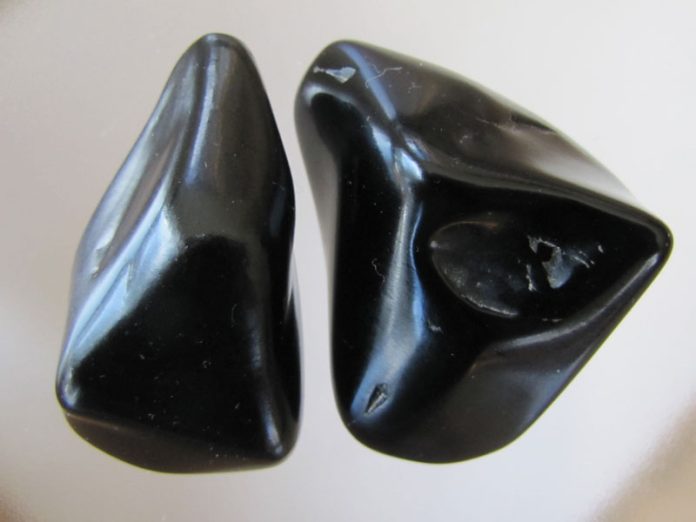
Jet stone as Shakespeare noted is, “coal-black,” and in fact, jet is itself a form of coal. In Henry VI, William Shakespeare describes the Duke of Gloucester’s gown as “…Black, forsooth: coal-black as jet,” a fitting simile for a pure, saturated black color. Lexicologists suggest that our modern term “jet-black” stems directly from Shakespeare’s usage of the word “jet.”

A Form of Coal
Coal is technically a rock, a combustible material formed by the decomposition and destructive distillation of biomass material in an oxygen-free environment. Coalification, the process of coal formation, begins when layers of plant material become buried and compressed under new forest growth and sediments. Elevated temperatures and pressures then alter these organic remains, driving off water and volatile compounds and concentrating the carbon in the remaining material.
Coal consists primarily of carbon, together with some oxygen and hydrogen, and smaller amounts of sulfur, iron, nitrogen and other elements. Variations in burial time, heat and pressure produce four basic commercial grades of coal: peat, lignite, bituminous (including subbituminous) and anthracite. Peat, a brown, crumbly precursor to true coal, contains only about 25 percent carbon.
But with longer burial times and increased heat and pressure, peat will alter into lignite, which consists of 30 to 40 percent carbon. Subbituminous and bituminous coal, called “soft coal,” contains 40 to 90 percent carbon and has a hardness of Mohs 2.0-2.5. Anthracite or “hard coal” consists of more than 90 percent carbon; at Mohs 2.5-3.0, anthracite is the hardest type of commercial coal.

Wikimedia Commons
The Origin of Jet
Jet is technically a rare type of lignite. While all commercial coals are derived from massive accumulations of plant matter and occur in seams ranging in thickness from a few feet to several hundred feet, jet is formed from individual tree trunks that became waterlogged, sank, and was buried in organic-rich sediments. Jet does not occur in massive seams, only in small, isolated pockets rarely more than a few inches in thickness.
Also unlike other types of coal, the structural and chemical nature of jet is influenced by the geochemical environment of the surrounding host rock, which is usually an organic-rich shale. As the jet develops, it absorbs oils and other hydrocarbon materials that are released by the decay of algae, plankton, and similar types of organic matter within the shale. Subsequently, the jet exhibits neither the extreme brittleness nor the extensive fracture systems common to other forms of coal.
At Mohs 3.0 to 4.0, the jet is by far the hardest type of coal. It is classified either as “hard jet,” which forms in marine environments, or “soft jet,” which develops in lacustrine or freshwater environments. All jet is opaque and exhibits a uniform, fine grain and a waxy-to velvety luster. It is easily carved and polishes to an attractive matte finish or a high sheen.
Jet consists of roughly 75 percent carbon, 12 percent oxygen, and lesser amounts of sulfur and hydrogen. It is easy to identify: when touched with a red-hot needle, jet emits a distinctive, coal-like odor.

Wikimedia Commons
A Jet History
Jet was collected and carved in Neolithic times. The oldest known jet artifact, recovered from a gravesite in Germany, dates to about 9000 B.C., making jet one of the oldest worked gem materials.
Whitby, located in Yorkshire in northeast England on the coast of the North Sea, has always been the world’s premier source of high-quality jet. The systematic collecting of jet for trading purposes had begun on the Whitby beaches by 1500 B.C. Jet later became especially popular among the Romans who obtained it from the same beaches.
Whitby jet, which is nearly altered to a subbituminous state, originated about 180 million years ago in a Jurassic Period saltwater swamp. The jet that washes onto the Whitby beaches is periodically replenished when North Sea storms erode the sea bottom. Some pieces of Whitby jet retain the shape of the original tree branches and trunks and are especially valuable as collector specimens.
By the time the popularity of jet jewelry peaked in England during the 1870s, collecting and working jet had become an industry in Whitby and a major part of the local economy. More than 1,000 Whitby residents were involved in collecting, working, or marketing jet, which was fashioned into cabochons and beads for jewelry, and into an array of small decorative objects, all of which were traded throughout the British Isles, Europe, and North America.

Wikimedia Common
Jet the Gemstone
Part of jet’s popularity as a gem is because of its very low density. With a specific gravity of only 1.3-1.4, jet is half as dense as other black gemstones—a big advantage when wearing the long, bulky necklaces popular in Victorian Era mourning jewelry and the multiple-strand, “flapper” necklaces of the Roaring Twenties. Jet is also one of the few opaque gem materials that is commonly faceted.
Jet’s popularity in jewelry began fading during the 1930s in the face of competition from schorl (black tourmaline); dyed chalcedony; inexpensive imitations including black glass, plastic, and vulcanized rubber; and the growing acceptance of Art Deco jewelry styles which made little use of black gem materials.
Although Whitby remains the leading source of jet, this gem variety of coal is also found in Spain, France, Germany, Poland, Turkey, and Canada. In the United States, jet is found in Colorado and Utah where certain Native American groups continue to use it in jewelry and ceremonial objects, often in combination with turquoise and red coral.
Available today as beads, cabochons, and small decorative objects, as well as natural specimens, jet retains its distinctive identity as the rarest type of coal, one of the few organic gemstones and, thanks to William Shakespeare, an enduring simile for the color black.
This story about jet stone previously appeared in Rock & Gem magazine. Click here to subscribe. Story by Steve Voynick.












